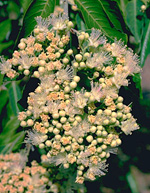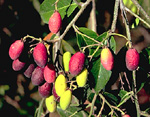 |
Two species of this primarily American family occur in northern Australia, from Cape York Peninsula to the Top End of the Northern Territory. They occur in rain forest, monsoon forest and in coastal scrubs.
Characteristic features of the family Chrysobalanaceae in Australia include: - trees, with alternate, entire leaves
- flowers fragrant, in terminal or axillary panicles, almost regular to strongly zygomorphic, white, cream, yellow, brown or purple
- ovary eccentric (i.e. not in the centre of the flower), with a lateral or basal style
- fruit a yellow, orange, red, purple, violet, blue, brown or black or green, 1-seeded drupe
Description
Evergreen trees or shrubs. Internal secretions not obvious. Plants glabrous or with simple, non-glandular, unicellular hairs. Leaves alternate and spiral, petiolate. Stipules present, distinct and free from the petiole, scale-like, membranous or bristle-like, falling off early. Lamina simple, symmetric, lanceolate, ovate, elliptic or oblong; base cuneate or rounded; margins entire, ±flat; venation pinnate, with the midrib conspicuous, and the tertiary venation reticulate or not; surfaces not punctate; herbaceous or leathery. Plants with all the flowers bisexual. Inflorescences terminal or axillary, consisting of glomerules, panicles or corymbs. Bracts present. Bracteoles present or absent. Pollination by insects. Flowers fragrant; sessile or stalked. Floral disc present; nectaries present on the disc. Free hypanthium present. Perianth of 2 dissimilar whorls, imbricate in bud. Calyx segments regular, apparently fused, with 5 lobes; calyx cup-shaped or bell-shaped, herbaceous. Corolla segments regular or irregular, free, with 5 or apparently 0 petals, alternating with the calyx lobes; corolla white, cream or yellow, without contrasting markings, membranous; claws present or absent; lobes ±entire. Fertile stamens 5–numerous, not clearly correlated with the calyx lobes, at least partly fused to the corolla, free of the ovary or the style, distinct from each other or fused by their filaments into an open or closed tube, all ±equal. Staminodes present. Anthers dorsifixed, versatile, opening inwards by longitudinal slits; 2-celled. Ovary superior and sessile. Carpels 1 or 3, free or fused; ovary with 1–2 locules. Style gynobasic, single and unbranched. Ovules 1 per locule, stalked; placentation basal. Fruit a fleshy, indehiscent drupe; the perianth on the maturing fruit deciduous. Disseminule macro-surface featureless, costate or with straight hairs; micro-surface ±smooth, yellow, orange, red, magenta, purple, violet, green or brown. Seeds 1 per fruit. Cotyledons 2. Embryo straight.
(Note: this description has been generated from the coded data compiled for the key. Any errors in the key data will be reflected in the descriptions.)
A treatment of the family Chrysobalanaceae has not yet been published
in the Flora of Australia. It will appear in Volume 10.
Australian genera of Chrysobalanaceae (as recognised for the Flora of Australia)
Maranthes
Parinari

|
  |

Maranthes corymbosa (flowers)
Photo: D.Jones © D.Jones

Maranthes corymbosa (fruits)
Photo: D.Jones © D.Jones
|
 |
|